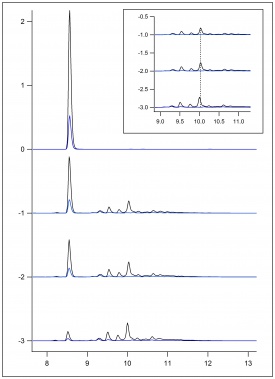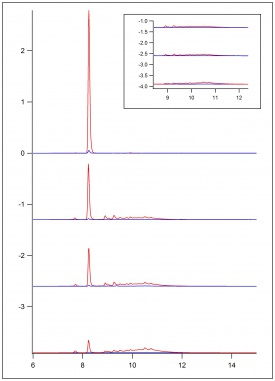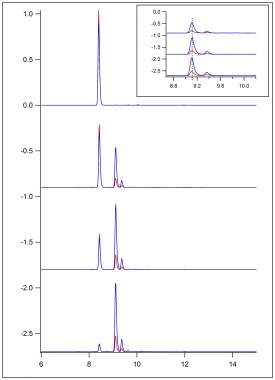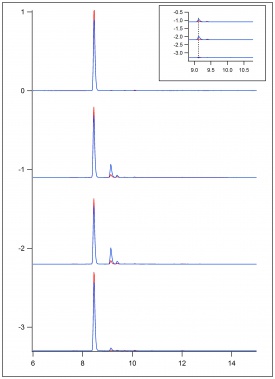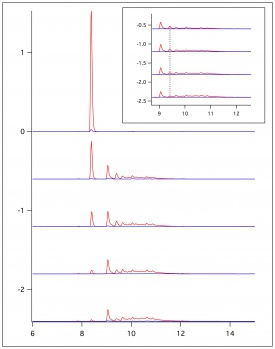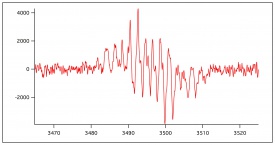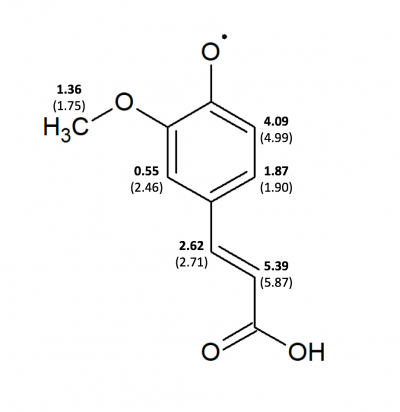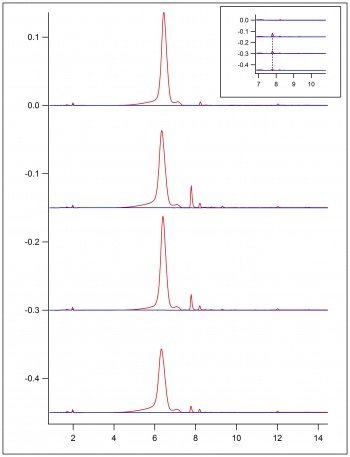Oxidative Properties of Lignin & Similar Compounds
You have reached the page dedicated to the research completed regarding the oxidation of lignin monomers during the summer of 2018 with the Doc Kieft Summer Research Program. This research is completed by Zelinda Taylor under the direction of Dr. Bradley Sturgeon.
Lignin Compounds
Lignin Monomers
Abstract
The lignin polymer is synthesized via oxidative coupling of three basic monomers: p-coumaryl alcohol, coniferyl alcohol, and sinapyl alcohol. These three monomers each possess a phenol group that stabilizes the radical intermediate generated during the oxidation reaction. Although some literature exists showing the ESR spectra of these short-lived radical intermediates, we have revisited these intermediates using a combination of experimental techniques [HPLC and immobilized enzyme-ESR technique (IE-ESR)] and computational approaches [B3YLP/ESR-II and WINSIM].
Oxidation of Monomers
Beaker reactions with varying reaction conditions were completed to analyze the oxidation of each monomer. For each monomer, 100 mL of a 2 mM standard solution of the monomer was made using 50/50 dioxane/pH 5 buffer. Three reactions were then completed with varying concentrations of hydrogen peroxide in the presence of HRP. The first reaction was composed of 5 mL of the substrate, 10 µL of hydrogen peroxide (1 mM final concentration hydrogen peroxide) and 5 µL of HRP. The second reaction was composed of 5 mL of the substrate, 5 µL of hydrogen peroxide (0.5 mM final concentration hydrogen peroxide) and 5 µL of HRP. The third reaction was composed of 5 mL of the substrate, 5 µL of hydrogen peroxide (0.25 mM final concentration hydrogen peroxide) and 5 µL of HRP. These reactions were then analyzed on the HPLC for oxidation products of each monomer.
Analysis of Monomer Oxidation
The reactions and the standards were analyzed on the HPLC using an acetonitrile (ACN) and water gradient for 25 minutes. The first 10 minutes were ran at 100% water, 10-20 minutes were ran at an 80% ACN/20% water gradient, and the remaining 5 minutes at 100% water. This method is saved as "pCou_100417_SAZT."
| Ferulic Acid | Ferulic Acid | P-Coumaric Acid | Synapic Acid |
Immobilization of Enzymes
An immobilization of peroxidase from horseradish (HRP) was completed using Affi-Gel 10. This procedure is centered around the isolectric point of the enzyme. The immobilization was completed using a MOPS buffer (pH 7.0) and about 2 mL of Affi-Gel 10 beads. The absorbance of the initial HRP in MOPS buffer was 6.28. The initial concentration of HRP was 616 µM. A successful immobilization of the enzyme results in a smaller absorbance. The smaller absorbance means there has been greater coupling between the enzyme and the beads. The final absorbance was 1.9 and the final concentration was 190 µM.
Oxidation of Lignin Monomers Using Immobilized HRP
Beaker reactions were completed using the immobilized HRP and analyzed on the HPLC. The reactions had varying concentrations of hydrogen peroxide. A 2 mM standard was made for each monomer with a volume of 100 using 50/50 dioxane/pH 5 buffer. The first reaction was composed of 5 mL of substrate, 10 µL hydrogen peroxide (1 mM final concentration hydrogen peroxide), and 50 µL of immobilized HRP. The second reaction was composed of 5 mL of substrate, 5 µL of hydrogen peroxide (0.5 mM final concentration hydrogen peroxide), and 50 µL of immobilized HRP. The third reaction was composed of 5 mL of substrate, 2.5 µL of hydrogen peroxide (0.25 mM final concentration hydrogen peroxide), and 50 µL of immobilized HRP. These reactions were then analyzed on the HPLC for possible oxidation products using the method "pcou_100417_SAZT" for 25 minutes. The results were then compared to previously collected HPLC data using HRP, opposed to immobilized HRP.
| Ferulic Acid | P-Coumaric Acid | Synapic Acid |
The sinapic acid produced unpredicted results. The sinapic acid reactions using HRP in pH 5 buffer and dioxane produced no product peaks. The sinapic acid reactions using HRPi in pH 5 buffer produced product peaks. New reactions (using the same method as above) using sinapic acid and HRP or HRPi in pH 5 buffer were made. The results were then analyzed on the HPLC using the method "pCou_100417_SAZT" and ran for 25 minutes.
| Sinapic Acid | Sinapic Acid |
The immobilized HRP was loaded in an ESR flat cell so a substrate solution could be flowed over the immobilized enzyme at different flow rates between 0.25 mL/min and 2 mL/min. The ESR flat cell was loaded with glass wool, sand, and then immobilized enzyme. A substrate of 1 mM ferulic acid and 1 mM hydrogen peroxide in pH 5 buffer was flowed over the substrate. Samples were collected with the flow at 0.25 mL/min, 0.5 mL/min, 1 mL/min, and 2 mL/min. These samples were then analyzed on the HPLC using the method "pCou_100417_SAZT" and ran for 25 minutes.
| Ferulic Acid |
The previous HPLC data showed no products. This is because the possible dimers and polymers adhered to the agarose beads with HRPi in the flat cell. To remove these dimers, about 3 mL of dioxane was pushed through the flat cell. A sample was then collected. A HPLC vile was filled with dioxane until it was about 2/3 full. Then 20 μL of the collected dioxane sample was pipetted into the HPLC vile. We most likely could not have simply ran the collected dioxane sample, as it would have been too concentrated for the HPLC to detect the products. This was then ran on the HPLC with the method "pCou_100417_SAZT" for 25 minutes.
The flat cell was loaded with steel wool, sand, and agarose beads with HRPi. Buffer was then ran over the beads in the flat cell. A substrate of 1 mM ferulic acid, and 1 mM hydrogen peroxide in 50/50 dioxane/pH 5 buffer was made. It was then ran over the immobilized enzyme in the flat cell. Samples were then collected with flow at 0.25 mL/min, 0.5 mL/min, 1 mL/min, and 2 mL/min. These samples were then ran on the HPLC using the method "pCou_100417_SAZT" for 25 minutes.
The flat cell was loaded with steel wool, sand, and immobilized enzyme. Buffer was ran over the flat cell for about 5 minutes. A substrate of 1 mM p-coumaric acid and 1 mM hydrogen peroxide in 50/50 dioxane/pH 5 buffer was ran over the immobilized enzyme in the flat cell. Samples were collected at flow rates of 0.25 mL/min, 0.5 mL/min, 1 mL/min, and 2 mL/min. These samples were then ran on the HPLC using the method "pCou_100417_SAZT" for 25 minutes.
ESR Detection of Radicals
To complete preliminary ESR data collection using ferulic acid, a substrate of 1 mM ferulic acid in 50/50 dioxane/pH 5 buffer was made. The flat cell was then loaded with steel wool, sand, and immobilized enzyme. Buffer was ran over the immobilized enzyme for about an hour. The flat cell was then mounted in the ESR. Hydrogen peroxide was added to the substrate so its concentration in solution was 1 mM. The substrate was then flowed over the flat cell in the ESR at a flow rate of 1 mL/min and a signal was collected. The flow of the substrate was then increased to 2 mL/min and a signal was collected. The flow of the substrate was then stopped. No signal was apparent. The flow was then started with a flow rate of 2 mL/min, and the signal returned.
| 1 mL/min | 2 mL/min | No flow | 2 mL/min |
Below are the ESR spectra of ferulic acid and coniferyl alcohol collected with a flow rate of 1 mL/min. The spectra below are the simulated spectra using WINSIM software and WebMO Pro 18 to calculate coupling constants of the possible radical locations on the molecule.
Comparison of Ferulic Acid and Coniferyl Alcohol Using WebMO Calculations & WINSIM Simulation
| Position | Coniferyl Alcohol (G03) | Coniferyl Alcohol (sim-Burrkitt) Chemical ox | Coniferyl Alcohol (sim) g-shift -0.26, LS 22, LW 0.32 | Ferulic Acid (G03) | Ferulic Acid (sim-Burkitt) | Ferulic Acid (sim) g-shift: 1.46, LS: 80.9, LW: 0.34 |
| 10 (ortho to -OH) | 5.01 | 5.33 | 5.52 | 4.99 | 5.56 | 4.09 |
| 11 (meta to -OH) | 1.57 | 1.86 | 1.78 | 1.90 | 1.70 | 1.87 |
| 20 (ortho to -OCH3) | 2.56 | 1.16 | 1.18 | 2.46 | 1.53 | 0.55 |
| 19 (on alpha C | 2.49 | 2.32 | 3.08 | 2.71 | 2.64 | 2.62 |
| 18 (on beta C) | 6.0 | 5.50 | 7.16 | 5.87 | 5.28 | 5.39 |
| 17 (on gamma C | 1.29 | 3.92 | 3.97 | x | x | x |
| 21 (-OCH3) | 2.77 | 1.38 | 1.78 | 0.15 | 1.69 | 1.36 |
| 22 (-OCH3) | 0.15 | 1.38 | 1.78 | 2.54 | 1.69 | 1.36 |
| 23 (-OCH3) | 2.75 | 1.38 | 1.78 | 2.55 | 1.69 | 1.36 |
| Coniferyl Alcohol Radical | Ferulic Acid Radical | |
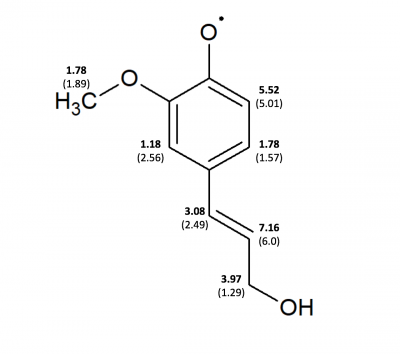
|
Similar Compounds
Oxidation of 4-hydroxy-3-methoxybenzyl
The same beaker reactions used for the lignin monomers were completed with the 4-hydroxy-3-methoxybenzyl. A 2 mM standard was created with a volume of 100 mL using 50/50 dioxane/pH 5 buffer.
Analysis of 4-hydroxy-3-methoxybenzyl Oxidation
Oxidation of Vanillin
The same beaker reactions used for the lignin monomers were completed were completed with vanillin. A 2 mM standard was created with a volume of 100 mL using 50/50 dioxane/pH 5 buffer.

